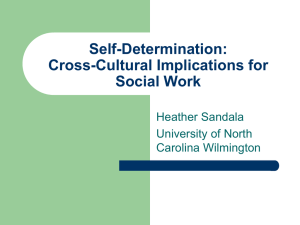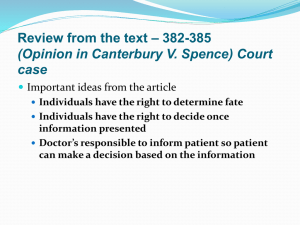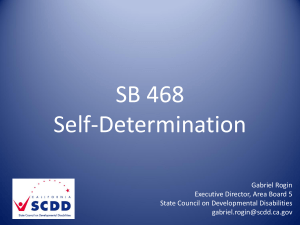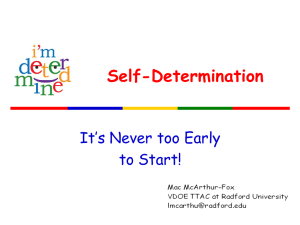District Self-Assessment: Promoting Student Self-Determination District Name:________________________________________
advertisement
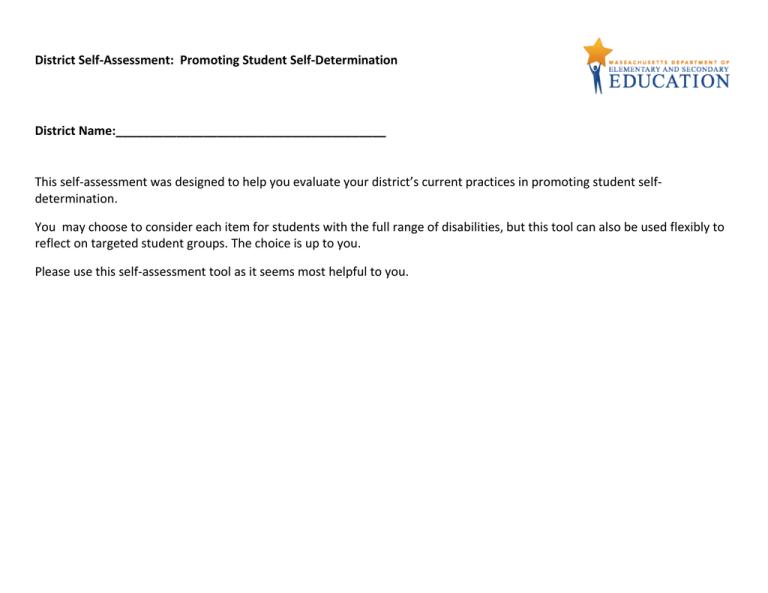
District Self-Assessment: Promoting Student Self-Determination District Name:________________________________________ This self-assessment was designed to help you evaluate your district’s current practices in promoting student selfdetermination. You may choose to consider each item for students with the full range of disabilities, but this tool can also be used flexibly to reflect on targeted student groups. The choice is up to you. Please use this self-assessment tool as it seems most helpful to you. District Self-Assessment: Promoting Student Self-Determination OVERALL STUDENT SELF-DETERMINATION Internal Locus of Control: Students believe that they – and not some external factor(s) – have control over outcomes that are important to their lives. Self-Efficacy: Students believe that they can successfully execute whatever behavior is required to produce a given outcome. Choice- and Decision-Making: Students can acquire needed information and choose among two or more known options. Problem-Solving: Students can overcome challenges to achieve a solution when the solution is not initially obvious. Goal-Setting and Attainment: Students can decide what they want, determine how they are going to accomplish what they want, implement and adjust their strategies, and then measure their own success. Self-Regulation: Students observe, evaluate, and reward themselves. They monitor their own actions. Self Advocacy: Students are able to speak and act effectively on their own behalf, in order to obtain what they need and want; being a leader in your own life. Self-Awareness and Self-Knowledge: Students know their own strengths, weaknesses, abilities, and limitations, and know how to use these to beneficially influence their lives. Students are supported to develop skills listed in the left-hand column: Never Sometimes Most of Always Evidence (How do you the time know?/What does this look like in your district?) District Self-Assessment: Promoting Student Self-Determination District Self-Assessment: Promoting Student Self-Determination OVERALL STUDENT SELF-DETERMINATION (cont’d) We provide our students with opportunities to try and succeed/fail. Our students have opportunities to be leaders and mentors. Experiences that students without disabilities have in our district set the standard for the experiences we provide for students with disabilities. Our students understand the concept of interdependence. We help students build skills to seek out, evaluate, and rely on trustworthy sources of support (i.e., mentors). Elements in the left-hand column occur: Never Sometimes Most of the time Always Evidence (How do you know?/What does this look like in your district?) District Self-Assessment: Promoting Student Self-Determination CONNECTIONS TO WHOLE-SCHOOL APPROACHES Student self-determination is supported through linkages with the Massachusetts Definition of College and Career Readiness. Student self-determination is supported through linkages with Social-Emotional Learning Curricula. Student self-determination is supported through linkages with Positive Behavioral Interventions and Supports (PBIS). Student self-determination is supported through linkages with Individual Learning Plans (ILPs). Student self-determination is supported through linkages with Massachusetts Work-Based Learning Plans. Student self-determination is supported through linkages with Career Vocational Technical Education Career Plans. Student self-determination is supported through linkages with other whole-school initiatives (list): Families receive information on whole-school linkages to support the development of student self-determination. Students and Families partner with the school to support wholeschool linkages to support the development of student selfdetermination. Elements in the left-hand column occur: Never Sometimes Most of the time Always Evidence (How do you know?/What does this look like in your district?) District Self-Assessment: Promoting Student Self-Determination District Self-Assessment: Promoting Student Self-Determination STUDENT PARTICIPATION IN THEIR OWN IEP MEETINGS Students invite other members of the team, in advance of the meeting. Students introduce everyone at the IEP table. Students explain the purpose of the meeting to those attending. Students present their own accomplishments over the past year. Students present their own needs and challenges. Students lead the discussion of the TPF. Students propose annual goals. Students participate in the service delivery and placement discussion. Students evaluate the IEP meeting, including their own participation. Families receive information on school efforts to support student participation in their own IEP meetings. Students and families partner with the school to support student participation in their own IEP meetings. Elements in the left-hand column occur: Never Sometimes Most of Sometimes the time Evidence (How do you know?/What does this look like in your district?) District Self-Assessment: Promoting Student Self-Determination District Self-Assessment: Promoting Student Self-Determination FAMILY ENGAGEMENT Educators cultivate regular, two-way communication with families around student self-determination issues. Educators communicate about student self-determination in a culturally proficient manner with families. Families understand the importance of supporting their children to develop self-determination skills. Educators and families explicitly share responsibility for supporting student self-determination skills. Families understand how to support their children to develop self-determination skills. Families are provided with the tools they need to support the development of their children’s self-determination skills. Families support educators to help students develop selfdetermination skills. Elements in the left-hand column occur: Never Sometimes Most of Sometimes the time Evidence (How do you know?/What does this look like in your district?) District Self-Assessment: Promoting Student Self-Determination DISABILITY DISCLOSURE Students receive explicit instruction on disability disclosure. Students understand the legal issues involved in disability disclosure. Students understand the interpersonal issues involved in disability disclosure. Students are given opportunity and space to reflect on disability disclosure. Students are given opportunities to practice disability disclosure. Families receive information on disability disclosure. Students and Families partner with the school to support students in disability disclosure. Elements in the left-hand column occur: Never Sometimes Most of Sometimes the time Evidence (How do you know?/What does this look like in your district?) District Self-Assessment: Promoting Student Self-Determination STUDENT PARTICIPATION IN DEVELOPING THE SUMMARY OF PERFORMANCE (SOP) Elements in the left-hand column occur: Never Students self-assess their own academic performance. Students are offered opportunities to reflect on their own academic performance, as assessed by others. Students self-assess their own functional performance. Students are offered opportunities to reflect on their own functional performance, as assessed by others. Students articulate the supports they will need to succeed in postsecondary education/training. Students articulate the supports they will need to succeed in employment. Students articulate the supports they will need to succeed in community experiences/independent living (e.g. transportation, money management, healthcare, etc.). Families receive information on the Summary of Performance. Students and Families partner with the school to support students in the development of the Summary of Performance. Sometimes Most of the time Sometimes Evidence (How do you know?/What does this look like in your district?)
